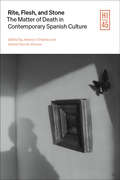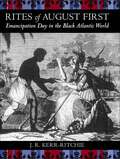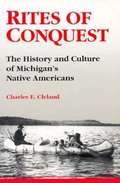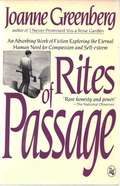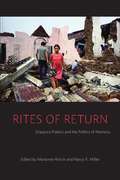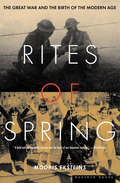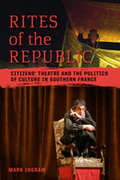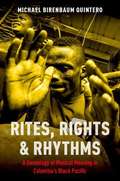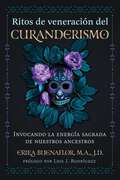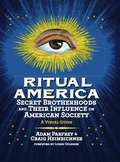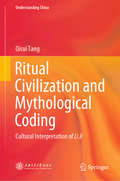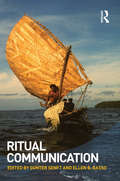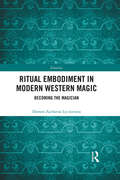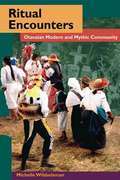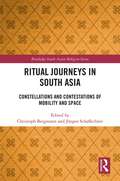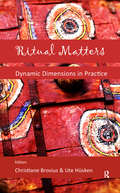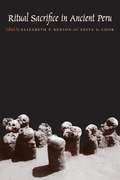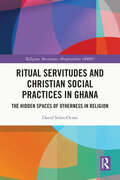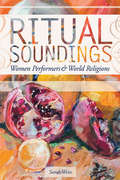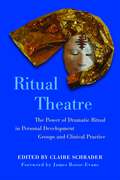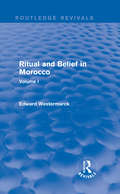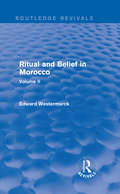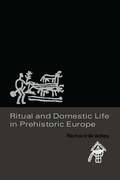- Table View
- List View
Rite, Flesh, and Stone: The Matter of Death in Contemporary Spanish Culture (Hispanic Issues)
by Elizabeth Scarlett William Viestenz Layla Renshaw N. Michelle Murray Eugenia Afinoguénova Pedro Aguilera-Mellado Ana Fernández-Cebrián Patty Keller Ángel Loureiro Cristina Moreiras-Menor Annabel Martín Jordi Moreras Sol TarrésForensic science provides information and data behind the circumstances of a particular death, but it is culture that provides death with meaning. With this in mind, Rite, Flesh, and Stone proposes cultural matters of death as its structuring principle, operating as frames of the expression of mortality within a distinct set of coordinates. The chapters offer original approaches to how human remains are handled in the embodied rituals and social performances of contemporary funeral rites of all kinds; furthermore, they explore how dying flesh and corpses are processed by means of biopolitical technologies and the ethics of (self-)care, and how the vibrant and breathing materiality of the living is transformed into stone and analogous kinds of tangible, empirical presence that engender new cartographies of memory. Each coming from a specific disciplinary perspective, authors in this volume problematize conventional ideas about the place of death in contemporary Western societies and cultures using Spain as a case study. Materials analyzed here—ranging from cinematic and literary fictions, to historical archives and anthropological and ethnographic sources—make explicit a dynamic scenario where actors embody a variety of positions toward death and dying, the political production of mortality, and the commemoration of the dead. Ultimately, the goal of this volume is to chart the complex network in which the disenchantment of death and its reenchantment coexist, and biopolitical control over secularized bodies overlaps with new avatars of the religious and non-theistic desires for memorialization and transcendence.
Rites of August First: Emancipation Day in the Black Atlantic World (Antislavery, Abolition, and the Atlantic World)
by Jeffrey R. Kerr-RitchieThirty years before Lincoln issued the Emancipation Proclamation, the antislavery movement won its first victory in the British Parliament. On August 1, 1834, the Abolition of Slavery Bill took effect, ending colonial slavery throughout the British Empire. Over the next three decades, "August First Day," also known as "West India Day" and "Emancipation Day," became the most important annual celebration of emancipation among people of African descent in the northern United States, the British Caribbean, Canada West, and the United Kingdom and played a critical role in popular mobilization against American slavery. In Rites of August First, J. R. Kerr-Ritchie provides the first detailed analysis of the origins, nature, and consequences of this important commemoration that helped to shape the age of Anglo-American emancipation.Combining social, cultural, and political history, Kerr-Ritchie discusses the ideological and cultural representations of August First Day in print, oratory, and visual images. Spanning the Western hemisphere, Kerr-Ritchie's study successfully unravels the cultural politics of emancipation celebrations, analyzing the social practices informed by public ritual, symbol, and spectacle designed to elicit feelings of common identity among blacks in the Atlantic World. Rites of August First shows how and why the commemorative events changed between British emancipation and the freeing of slaves in the United States a generation later, while also examining the connections among local, regional, and international commemorations.While shedding light on an important black institution that has been long ignored, Rites of August First also contributes to the broader study of emancipation and black Atlantic identity. Its transnational approach challenges local and national narratives that have largely shaped previous investigations of these questions. Kerr-Ritchie shows how culture and community were truly political at this important historical moment and, most broadly, how politics and culture converge and profoundly influence each other.
Rites of Conquest: The History and Culture of Michigan's Native Americans
by Charles ClelandFor many thousands of years before the arrival of Europeans, Michigan's native peoples, the Anishnabeg, thrived in the forests and along the shores of the Great Lakes. Theirs were cultures in delicate social balance and in economic harmony with the natural order. Rites of Conquest details the struggles of Michigan Indians - the Ojibwa, Ottawa, and Potawatomi, and their neighbors - to maintain unique traditions in the wake of contact with Euro-Americans. The French quest for furs, the colonial aggression of the British, and the invasion of native homelands by American settlers is the backdrop for this fascinating saga of their resistance and accommodation to the new social order. Minavavana's victory at Fort Michilimackinac, Pontiac's attempts to expel the British, Pokagon's struggle to maintain a Michigan homeland, and Big Abe Le Blanc's fight for fishing rights are a few of the many episodes recounted in the pages of this book.
Rites of Passage
by Joanne GreenbergThis is a collection of twelve short stories with varying themes and settings. In the title story, a teenage boy raised by elderly aunts strives to become a man, with disastrous consequences. In "Upon the Waters" an old farmer creates chaos in a social service agency when he attempts to repay society for the help he received during the Great Depression.<P><P> Man Booker Prize winner
Rites of Return: Diaspora Poetics and the Politics of Memory (Gender and Culture Series)
by Marianne Hirsch Nancy K. MillerThe first decade of the twenty-first century witnessed a passionate engagement with the losses of the past. Rites of Return examines the effects of this legacy of historical injustice and documented suffering on the politics of the present. Twenty-four writers, historians, literary and cultural critics, anthropologists and sociologists, visual artists, legal scholars, and curators grapple with our contemporary ethical endeavor to redress enduring inequities and retrieve lost histories. Mapping bold and broad-based responses to past injury across Eastern Europe, Africa, Latin America, Australia, the Middle East, and the United States, Rites of Return examines new technologies of genetic and genealogical research, memoirs about lost family histories, the popularity of roots-seeking journeys, organized trauma tourism at sites of atrocity and new Museums of Conscience, and profound connections between social rites and political and legal rights of return.Contributors include: Lila Abu-Lughod, Columbia University; Nadia Abu El-Haj, Barnard College; Elazar Barkan, Columbia University; Svetlana Boym, Harvard University; Saidiya Hartman, Columbia University; Amira Hass, journalist; Jarrod Hayes, University of Michigan; Marianne Hirsch, Columbia University; Eva Hoffman, writer; Margaret Homans, Yale University; Rosanne Kennedy, Australian National University; Daniel Mendelsohn, writer; Susan Meiselas, photographer; Nancy K. Miller, CUNY Graduate Center; Alondra Nelson, Columbia University; Jay Prosser, University of Leeds; Liz Sevchenko, Coalition of Museums of Conscience; Leo Spitzer, Dartmouth College; Marita Sturken New York University; Diana Taylor, New York University; Patricia J. Williams, Columbia University
Rites of Spring: The Great War and the Birth of the Modern Age
by Modris EksteinsThis award-winning cultural history reveals how the Great War changed humanity. This sweeping volume probes the origins, the impact, and the aftermath of World War I—from the premiere of Igor Stravinsky&’s ballet The Rite of Spring in 1913 to the death of Hitler in 1945. &“The Great War,&” as Modris Eksteins writes, &“was the psychological turning point . . . for modernism as a whole. The urge to create and the urge to destroy had changed places.&” In this &“bold and fertile book&” (The Atlantic Monthly), Eksteins goes on to chart the seismic shifts in human consciousness brought about by this great cataclysm, through the lives and words of ordinary people, works of literature, and such events as Lindbergh&’s transatlantic flight and the publication of the first modern bestseller, All Quiet on the Western Front. Rites of Spring is a rare and remarkable work, a cultural history that redefines the way we look at our past—and toward our future.
Rites of the Republic: Citizens' Theatre And The Politics Of Culture In Southern France (Teaching Culture: Utp Ethnographies For The Classroom Ser.)
by Mark IngramIn this fascinating exploration of citizenship and the politics of culture in contemporary France, Ingram examines two theatre troupes in Provence: one based in a small town in the rural part of the Vaucluse region, and the other an urban project in Marseille, France's most culturally diverse city. Both troupes are committed to explicitly civic goals in the tradition of citizens' theatre. Focusing on the personal stories of the theatre artists in these two troupes, and the continuities between their narratives, their performances, and the national discourse directed by the Ministry of Culture, Ingram examines the ways in which these artists interpret universalistic ideals underlying both art and the Republic in their theatrical work. In the process he charts the evolution of new models for society and citizenship in a rapidly changing France.
Rites, Rights And Rhythms: A Genealogy Of Musical Meaning In Colombia's Black Pacific (Currents In Latin Amer And Iberian Music)
by Michael Birenbaum QuinteroColombia has the largest black population in the Spanish-speaking world, but Afro-Colombians have long remained at the nation's margins. Their recent irruption into the political, social, and cultural spheres is tied to appeals to cultural difference, dramatized by the traditional music of Colombia's majority-black Southern Pacific region, often called currulao. Yet that music remains largely unknown and unstudied despite its complexity, aesthetic appeal, and social importance. Rites, Rights & Rhythms: A Genealogy of Musical Meaning in Colombia's Black Pacific is the first book-length academic study of currulao, inquiring into the numerous ways it has been used: to praise the saints, to grapple with modernization, to dramatize black politics, to perform the nation, to generate economic development and to provide social amelioration in a context of war. Author Michael Birenbaum Quintero draws on both archival and ethnographic research to trace these and other understandings of how currulao has been understood, illuminating a history of struggles over the meanings of currulao that are also struggles over the meanings of blackness in Colombia. Moving from the eighteenth century to the present, Rites, Rights & Rhythms asks how musical meaning is made, maintained, and sometimes abandoned across historical contexts as varied as colonial slavery, twentieth-century national populism, and neoliberal multiculturalism. What emerges is both a rich portrait of one of the hemisphere's most important and understudied black cultures and a theory of history traced through the performative practice of currulao.
Ritos de veneración del curanderismo: Invocando la energía sagrada de nuestros ancestros
by Erika Buenaflor• Comparte ritos y prácticas de veneración tradicionales para conectarte con tus antepasados, incluidos rituales de limpieza, viajes de trance, trabajo energético y jardinería sagrada• Explora las prácticas ancestrales de elaboración de altares, herramientas sagradas para los altares y cómo invitar a tus antepasados a tomar un papel activo para intervenir en tu nombre• Describe el proceso de deificación de antepasados estimados y cómo esta práctica abre el acceso a poderes especiales para aquellos que comparten el linaje de ese antepasadoAl explorar los diversos y dinámicos ritos de veneración ancestral de los antiguos mesoamericanos, así como los que se practican en el curanderismo contemporáneo, Erika Buenaflor muestra cómo podemos aprovechar estas tradiciones para reconectarnos con nuestros antepasados, profundizar nuestros viajes de sanación y dar forma a nuestras vidas. Ella explica cómo los ancestros tienen energía sagrada que puede continuar en sus herederos físicos directos, renacer en el paisaje en sitios sagrados o manifestarse en otros seres que habitan las mismas tierras. Ella describe el proceso de deificación de los ancestros estimados y cómo esto abre el acceso a poderes especiales para aquellos que comparten el linaje de ese ancestro.Buenaflor examina las antiguas ofrendas y ceremonias sagradas utilizadas para asegurar la ayuda, guía e intervención de los antepasados, así como el bienestar y la comodidad de los antepasados en el más allá. Al llevar el conocimiento a la actualidad, comparte numerosos ritos de veneración y prácticas de sanación para fortalecer los lazos con sus antepasados, incluidos rituales de limpieza, elaboración de artesanías rituales, viajes de trance, respiración chamánica, trabajo energético con vidas pasadas y presentes, jardinería sagrada y altares ancestrales. Ella te introduce a la espiritualidad de Nepantla, el camino de la recuperación del espacio liminal sagrado, y te muestra cómo puedes sanar tu linaje ancestral y recuperar a tus estimados ancestros, aquellos que te anclan con un sentimiento de pertenencia a algo más grande, divino y hermoso.Ya sea que puedas crear un árbol genealógico largo y detallado o no tengas conocimiento de tus abuelos o incluso de tus padres, este libro ofrece muchas formas de conectarse con tus antepasados espirituales, sanar tu linaje y recibir ayuda espiritual mientras reclamas a tus antepasados y les da la bienvenida en tu vida.
Ritual America
by Adam Parfrey Craig Heimbichner"Adam Parfrey is one of the nation's most provocative publishers."--Seattle Weekly "Secret society historian Craig Heimbichner follows the Middle Path to wisdom. He works the graveyard shift in the secret lodge."--Joan d'Arc, Paranoia magazine Secret societies--now a staple of bestseller novels--are pictured as sinister cults that use hooded albinos to menace truth-seekers. Some conspiracy books claim that fraternal orders are the work of serpentine aliens and interbred humans who wish to supplant earth of its energy, and later, its very existence. On the other side of the aisle, books by high-ranked Freemasons--skeptical in tone but no less partisan in approach--protect their organization's public image by denying the existence of its most contentious ideas. Ritual America reveals the biggest secret of them all: that the influence of fraternal brotherhoods on this country is vast, fundamental, and hidden in plain view. In the early twentieth century, as many as one-third of America belonged to a secret society. And though fezzes and tiny car parades are almost a thing of the past, the Gnostic beliefs of Masonic orders are now so much a part of the American mind that the surrounding pomp and circumstance has become faintly unnecessary. The authors of Ritual America contextualize hundreds of rare and many never-before printed images with entertaining and far-reaching commentary, making an esoteric subject provocative, exciting, and approachable. Adam Parfrey is the author of Cult Rapture: Revelations of the Apocalyptic Mind and It's a Man's World: Men's Adventure Magazines, the Postwar Pulps. He is editor of the influential Apocalypse Culture series Love, Sex, Fear Death: The Inside Story of the Process Church of the Final Judgment. Craig Heimbichner has recently appeared on a National Geographic documentary about the Bohemian Grove, contributed to the Feral House compilation Secret and Suppressed II, and wrote about the famous occult order the O.T.O. in Blood and Altar.
Ritual Civilization and Mythological Coding: Cultural Interpretation of Li Ji (Understanding China)
by Qicui TangThis book places Li Ji (the Book of Rites) back in the overall context of “books,” “rites” and its research history, drawing on the interrelations between myth, ritual and “materialized” symbols to do so. Further, it employs the double perspectives of “books” and “rites” to explore the sources and symbols of the capping ceremony (rites of passage), decode the prototypes of Miao and Ming Tang, and restore the discourse patterns of “people of five directions.” The book subsequently investigates the formation and function of the Yue Ling calendar and disaster ritual, so as to reveal the human cognitive encoding and metalanguage of ritual behavior involved. In the process, it demonstrates that Li Ji, its textual memories, archaeological remains and “traditional ceremony” narratives are all subject to the latent myth coding mechanism in China’s cultural system, while the “compilation” and “materialized” remains are merely forms of ritual refactoring, interpretation and exhibition, used when authority seeks the aid of ritual civilization to strengthen its legitimacy and maintain the social order.
Ritual Communication (Wenner-Gren International Symposium Series)
by Gunter SenftRitual Communication examines how people create and express meaning through verbal and non-verbal ritual. Ritual communication extends beyond collective religious expression. It is an intrinsic part of everyday interactions, ceremonies, theatrical performances, shamanic chants, political demonstrations and rites of passage. Despite being largely formulaic and repetitive, ritual communication is a highly participative and self-oriented process. The ritual is shaped by time, space and the individual body as well as by language ideologies, local aesthetics, contexts of use, and relations among participants. Ritual Communication draws on a wide range of contemporary cultures - from Africa, America, Asia, and the Pacific - to present a rich and diverse study for students and scholars of anthropology, sociology and sociolinguistics.
Ritual Embodiment in Modern Western Magic: Becoming the Magician (Gnostica)
by Damon Zacharias LycourinosIn the Western world, magic has often functioned as an umbrella term for various religious beliefs and ritual practices that seek to influence events by harnessing supernatural power. The definition of these myriad occult and esoteric traditions have, however, usually come from those that are opposed to its practice; notably authorities in religious, legal and intellectual spheres. This book seeks to provide a new perspective, directly from the practitioners of modern Western magic, by exploring how a distinctive mode of embodiment and consciousness can produce a transition from an ‘ordinary’ to a ‘magical’ worldview. Starting with an introduction to the study of magic in the Western academy, the book then presents the author’s own participant observation of five ethnographic case studies of modern Western magic. The focus of these ethnographic case studies is directed towards ideas and methods the informants employ to self-legitimise and self-represent as ‘magicians’. It concludes by discussing the phenomenological implications and issues around embodiment that are inherent to the contemporary practice of magic. This is a unique insight into the lived experience of practitioners of modern magic. As such, it will be of keen interest to scholars of the Occult and New Religious Movements, as well as Religious Studies academics examining issues around the embodiment and the anthropology of religion.
Ritual Encounters: Otavalan Modern and Mythic Community
by Michelle WibbelsmanThis book examines ritual practices and public festivals in the Otavalo and Cotacachi areas of northern Andean Ecuador's Imbabura province. Otavaleños are a unique group in that they maintain their traditional identity but also cultivate a cosmopolitanism through frequent international travel. Rituals have persisted among this ethnic community as important processes for symbolically capturing and critically assessing cultural changes in the face of modern influences. Ritual Encounters thus offers an appreciation of the modern and mythic community as a single and emergent condition.
Ritual Human Sacrifice in Mesoamerica: Recent Findings and New Perspectives (Conflict, Environment, and Social Complexity)
by Rubén G. Mendoza Linda HansenThis edited volume addresses the environmental and cultural underpinnings of the kind of social conflict that spawned the origins and elaboration of ritualized human and animal sacrifice in Mesoamerica. The chapters variously document the place of cultural evolution and social complexity in the origins and elaboration of ritual human sacrifice, cannibalism, and trophy-taking across a broad spectrum of Mesoamerican cultural and social contexts that first saw the light of day before 2600 BCE, and rapidly developed and proliferated across the Mesoamerican world in the centuries to follow. They study the developments in sacrifice rituals through the centuries into the first millennium CE, when the Mexica Aztec and their allies had elevated ritual human sacrifice such that they produced a plethora of sacrificial acts, modes and manners of death, and associated deities to articulate the necro-cultures and blood-tribute of the times. The chapters further study present-day rites of Amerindian communities from throughout Mesoamerica that include paying homage to the deities of earth and sky through sacrifice and consumption of animal surrogates. The interdisciplinary effort undertaken by this international cadre of scientists, including anthropologists, bioarchaeologists, art historians, ethnohistorians, iconographers, and religious studies experts provides a particularly rich forum for launching an interrogation into the role of conflict, environment, and social complexity in the emergence and persistence of ritual violence and human sacrifice in the Mesoamerican world.
Ritual Journeys in South Asia: Constellations and Contestations of Mobility and Space (Routledge South Asian Religion Series)
by Christoph Bergmann Jürgen SchaflechnerThis book focuses on the ritualized forms of mobility that constitute phenomena of pilgrimage in South Asia and establishes a new analytical framework for the study of ritual journeys. The book advances the conceptual scope of ‘classical’ Pilgrimage Studies and provides empirical depth through individual case studies. A key concern is the strategies of ritualization through which actors create, assemble and (re-)articulate certain modes of displacement to differentiate themselves from everyday forms of locomotion. Ritual journeys are understood as being both productive of and produced by South Asia’s socio-economically uneven, politically charged and culturally variegated landscapes. From various disciplinary angles, each chapter explores how spaces and movements in space are continually created, contested and transformed through ritual journeys. By focusing on this co-production of space and mobility, the book delivers a conceptually driven and empirically grounded engagement with the diverse and changing traditions of ritual journeying in South Asia. Interdisciplinary in its approach, the book is a must-have reference work for academics interested in South Asian Studies, Religious Studies, Anthropology and Human Geography with a focus on pilgrimage and the socio-spatial ideas and practices of ritualized movements in South Asia.
Ritual Matters: Dynamic Dimensions in Practice
by Christiane Brosius Ute HüskenThis book explores the interaction of rituals and ritualised practices utilising a cross-cultural approach. It discusses whether and why rituals are important today, and why they are possibly even more relevant than before.
Ritual Sacrifice in Ancient Peru: New Discoveries and Interpretations
by Elizabeth P. Benson Anita G. CookPropitiating the supernatural forces that could grant bountiful crops or wipe out whole villages through natural disasters was a sacred duty in ancient Peruvian societies, as in many premodern cultures. Ritual sacrifices were considered necessary for this propitiation and for maintaining a proper reciprocal relationship between humans and the supernatural world. The essays in this book examine the archaeological evidence for ancient Peruvian sacrificial offerings of human beings, animals, and objects, as well as the cultural contexts in which the offerings occurred, from around 2500 B.C. until Inca times just before the Spanish Conquest. Major contributions come from the recent archaeological fieldwork of Steve Bourget, Anita Cook, and Alana Cordy-Collins, as well as from John Verano's laboratory work on skeletal material from recent excavations. Mary Frame, who is a weaver as well as a scholar, offers rich new interpretations of Paracas burial garments, and Donald Proulx presents a fresh view of the nature of Nasca warfare. Elizabeth Benson's essay provides a summary of sacrificial practices.
Ritual Servitudes and Christian Social Practices in Ghana: The Hidden Spaces of Otherness in Religion (Religion, Resistance, Hospitalities)
by David Stiles-OcranThis book explores the kinds of Christian service or diaconia that develop in non-institutionalized practices for supporting survivors of indigenous ritual servitude or Trokosi in Africa. Drawing on empirical research from Ghana, it examines the possibilities of freedom, equality, and dignity for liberated Trokosi and the manner in which these women’s experiences constitute a repudiation of dominant patriarchal family systems. With close attention to the work of indigenous parachurches – which function outside of institutionalized churches – in challenging the contemporary practice of ritual slavery and offering its survivors a lived space in which they need not remain “hidden” as they seek restoration and integration into wider society, Ritual Servitudes and Christian Social Practices in Ghana will appeal to scholars of sociology, theology, and religion with interests in gender, contemporary ministries and African religion.
Ritual Sites and Religious Rivalries in Late Roman North Africa
by Lander Shira L.In Ritual Sites and Religious Rivalries in Late Roman North Africa, Lander examines the rhetorical and physical battles for sacred space between practitioners of traditional Roman religion, Christians, and Jews of late Roman North Africa. By analyzing literary along with archaeological evidence, Lander provides a new understanding of ancient notions of ritual space. This regard for ritual sites above other locations rendered the act or mere suggestion of seizing and destroying them powerful weapons in inter-group religious conflicts. Lander demonstrates that the quantity and harshness of discursive and physical attacks on ritual spaces directly correlates to their symbolic value. This heightened valuation reached such a level that rivals were willing to violate conventional Roman norms of property rights to display spatial control. Moreover, Roman Imperial policy eventually appropriated spatial triumphalism as a strategy for negotiating religious conflicts, giving rise to a new form of spatial colonialism that was explicitly religious.
Ritual Soundings: Women Performers and World Religions (New Perspectives on Gender in Music)
by Sarah WeissThe women of communities in Hindu India and Christian Orthodox Finland alike offer lamentations and mockery during wedding rituals. Catholic women of southern Italy perform tarantella on pilgrimages while Muslim Berger girls recite poetry at Moroccan weddings. Around the world, women actively claim agency through performance during such ritual events. These moments, though brief, allow them a rare freedom to move beyond culturally determined boundaries. In Ritual Soundings, Sarah Weiss reads deeply into and across the ethnographic details of multiple studies while offering a robust framework for studying music and world religion. Her meta-ethnography reveals surprising patterns of similarity between unrelated cultures. Deftly blending ethnomusicology, the study of gender in religion, and sacred music studies, she invites ethnomusicologists back into comparative work, offering them encouragement to think across disciplinary boundaries. As Weiss delves into a number of less-studied rituals, she offers a forceful narrative of how women assert agency within institutional religious structures while remaining faithful to the local cultural practices the rituals represent.
Ritual Theatre
by Edited by Claire SchraderRitual theatre is a powerful healing system that has been practised since ancient times by early societies and in tribal communities. It has the ability to effect deep transformation in its participants, support growth and development, and resolve personal issues. This book considers the relevance of ritual theatre in contemporary life and describes how it is being used as a highly cathartic therapeutic process. With contributions from leading experts in the field of dramatherapy, the book brings together a broad spectrum of approaches to ritual theatre as a healing system. It explores the anthropological and tribal roots of dramatic ritual and proposes that ritual theatre finds its most potent expression in personal development work. The practical application of ritual theatre in various clinical settings is discussed and the final chapters explore the possibilities of ritual theatre as performance. Offering a comprehensive discourse on the theory, application and potential of ritual theatre, this book will be an essential text for all students and practitioners of dramatherapy, arts therapists, psychotherapists, psychologists, counsellors and theatre professionals.
Ritual and Belief in Morocco: Vol. I (Routledge Revivals)
by Edward WestermarckBetween the years of 1898 and 1926, Edward Westermarck spent a total of seven years in Morocco, visiting towns and tribes in different parts of the country, meeting local people and learning about their language and culture; his findings are noted in this two-volume set, first published in 1926. Alongside extensive reference material, including Westermarck’s system of transliteration and a comprehensive list of the tribes and districts mentioned in the text, the chapters discuss such areas as the influences on and relationship between religion and magic in Morocco, the origins of beliefs and practices, curses and witchcraft. This is the first volume of two dealing with the same subject, and will fascinate any student or researcher of anthropology with an interest in the history of ritual, culture and religion in Morocco.
Ritual and Belief in Morocco: Vol. II (Routledge Revivals)
by Edward WestermarckBetween the years of 1898 and 1926, Edward Westermarck spent a total of seven years in Morocco, visiting towns and tribes in different parts of the country, meeting local people and learning about their language and culture; his findings are noted in this two-volume set, first published in 1926. The first volume contains extensive reference material, including Westermarck’s system of transliteration and a comprehensive list of the tribes and districts mentioned in the text. The chapters in this, the second volume, explore such areas as the rites and beliefs connected with the Islamic calendar, agriculture, and childbirth. This title will fascinate any student or researcher of anthropology with an interest in the history of ritual, culture and religion in Morocco.
Ritual and Domestic Life in Prehistoric Europe
by Richard BradleyThis fascinating study explores how our prehistoric ancestors developed rituals from everyday life and domestic activities. Richard Bradley contends that for much of the prehistoric period, ritual was not a distinct sphere of activity. Rather it was the way in which different features of the domestic world were played out until they took on qualities of theatrical performance. With extensive illustrated case-studies, this book examines farming, craft production and the occupation of houses, all of which were ritualized in prehistoric Europe. Successive chapters discuss the ways in which ritual has been studied, drawing on a series of examples that range from Greece to Norway and from Romania to Portugal. They consider practices that extend from the Mesolithic period to the Early Middle Ages and discuss the ways in which ritual and domestic life were intertwined.
